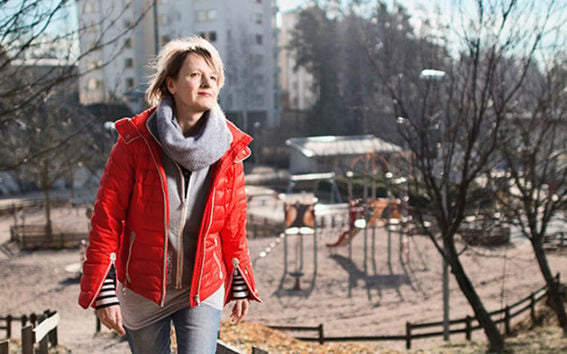Can you film debt?

Startled. That's what Documentary Film Professor, director Susanna Helke, was at the end of last year when news about a Kone Foundation grant was confirmed. The sum, €280,630, was more than what her team had applied for. When seeking funding for the Images of harmony and rupture research project, the team was well aware that the Foundation's new Is Finland becoming polarised? programme had drawn the interest of big-name applicants, including investigative journalists, social scientists and economists. Or, like she jokingly says, real researchers.
Susanna Helke applauds the Kone Foundation for their boldness and vision. Their Is Finland becoming polarised? programme hit fertile social ground. In a way, the Foundation encouraged exploration of uncharted territories, digging fresh ground to find out what it contains. Helke's team will use the means of documentary film to dig out and showcase the ongoing transition of the welfare state.
From emotions to economics
Images of harmony and rupture is a multi-year project and the intention is to get several documentary films started during it. An equally significant goal is to challenge the traditions of social documentaries.
“Models, formats that film-makers unconsciously follow, emerge from the traditions of documentary film,” Helke notes.
“Poverty has always been a solid subject when you wanted a documentary film to react to social transition. Go to a slum or the breadline. Such subjects are an avenue through which the viewer can be supplied with compassionate emotions that make them feel good.”
But, as society and societal rhetoric have changed, so must traditions also be challenged.
“An impulse that gets a new kind of thinking in motion is needed. It is important to consider how and why things are done and how they are perceived.”
Helke has noticed how the themes of the film-makers of her own generation distinctly hover around emotions and relationships. Documentaries about personal relationships, family ties and individual experiences have been created. But how to make visible the juxtaposition of material and immaterial values? Money defines everything, starting from how many substitute teachers a day care centre is allowed to hire during flu season. How to make a film about productivity?
Big money
€280,630 is a lot of cash. What does it get you?
“We are, of course, only getting started. We're now going to start exploring our subjects in earnest.”
At least four synopsis-stage documentary films are included in the project. Two of these are thesis works being made by Master's degree students. Post-doc researcher, director Jouko Aaltonen is working on a film of his own and Helke is also doing background research for a film.
“In the best case scenario, Images of harmony and rupture will initiate 4-7 films over a period of four years,” the professor outlines.
“The grant is, however, not enough to make all these movies. A lot depends on external funding.”
“We also engage in art-practice-led or artistic research. It creates an involvement with the traditions of societal documentary film and how it has reflected the various phases in the welfare state's history. Thus, tradition is challenged through making and writing.”
Articles and essays that will shed light on the subject within their own field and beyond the world of film-making will be published.
One way to reach outside the field of film, beyond the familiar, could come via a think-tank being planned by the team. It would connect film-makers with economics and social science experts. Helke reckons this think-tank would produce research in addition to synergy benefits and exchanges of ideas.
Even though the Images of harmony and rupture project is aimed at postgraduate film students, the think-tank should be beneficial to other students as well.
But where can the actual Images of harmony and rupture be seen? “A film called Hoivatyöläisen nauru (The care worker's laugh) is in the preparatory stage. I'm trying to grasp the paradoxes associated with the madness of trying to turn the immaterial into something that can be counted. I want to parade a large group of the heroic women who work in care in front of the camera. The project also has other film ideas, all of which in one way or another reflect the paradoxes that are associated with this ongoing transition.”
We'll have to wait for the finished documentary films on harmony and rupture. After meeting with this director-professor, I nevertheless dare suspect that we'll be seeing images of debt, regeneration, care, economics and productivity.
Text: Tiiu Pohjolainen
Photo: Heidi-Hanna Karhu
The original article has been published in the Aalto University Magazine issue 13. (issuu.com)
Read more news

Get to know us: Associate Professor Maria Sammalkorpi
Sammalkorpi received her doctorate from Helsinki University of Technology 2004. After her defence, she has worked as a researcher at the Universities of Princeton, Yale and Aalto.
Aalto computer scientists in ICML 2024
Computer scientists in ICML 2024
Getting bacteria into line
Physicists use magnetic fields to manipulate bacterial behaviour